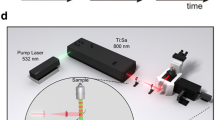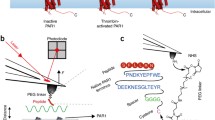Abstract
Membrane protein structures are highly under-represented relative to water-soluble protein structures in the protein databank. This is especially the case because membrane proteins represent more than 30% of proteins encoded in the human genome yet contribute to less than 10% of currently known structures (Torres et al. in Trends Biol Sci 28:137–144, 2003). Obtaining high-resolution structures of membrane proteins by traditional methods such as NMR and x-ray crystallography is challenging, because membrane proteins are difficult to solubilise, purify and crystallize. Consequently, development of methods to examine protein structure in situ is highly desirable. Fluorescence is highly sensitive to protein structure and dynamics (Lakowicz in Principles of fluorescence spectroscopy, Springer, New York, 2007). This is mainly because of the time a fluorescence probe molecule spends in the excited state. Judicious choice and placement of fluorescent molecule(s) within a protein(s) enables the experimentalist to obtain information at a specific site(s) in the protein (complex) of interest. Moreover, the inherent multi-dimensional nature of fluorescence signals across wavelength, orientation, space and time enables the design of experiments that give direct information on protein structure and dynamics in a biological setting. The purpose of this review is to introduce the reader to approaches to determine oligomeric state or quaternary structure at the cell membrane surface with the ultimate goal of linking the oligomeric state to the biological function. In the first section, we present a brief overview of available methods for determining oligomeric state and compare their advantages and disadvantages. In the second section, we highlight some of the methods developed in our laboratory to address contemporary questions in membrane protein oligomerization. In the third section, we outline our approach to determine the link between protein oligomerization and biological activity.

Similar content being viewed by others
References
Axelrod D, Koppel D, Schlessinger J, Elson E and Webb W 1976 Mobility measurement by analysis of fluorescence photobleaching recovery kinetics. Biophys. J. 16 1055–1069
Bacia K, Kim SA and Schwille P 2006 Fluorescence cross-correlation spectroscopy in living cells. Nature Methods 3 83–89
Berezin MY and Achilefu S 2011 Fluorescence lifetime measurements and biological imaging. Chem. Rev. 110 2641–2684
Chakraborty H, Jafurulla Md, Clayton AHA and Chattopadhyay A 2018 Exploring oligomeric state of the serotonin1A receptor utilizing photobleaching image correlation spectroscopy: implications for receptor function. Faraday Discuss. 207 409–421
Chen Y, Müller JD, So PT and Gratton E 1999 The photon counting histogram in fluorescence fluctuation spectroscopy. Biophys. J. 77 553–567
Chung I, Akita R, Vandlen R, Toomre D, Schlessinger J and Mellman I 2010 Spatial control of EGF receptor activation by reversible dimerization on living cells. Nature 464 783–787
Ciccotosto GD, Kozer N, Chow TT, Chon JW and Clayton AH 2013 Aggregation distributions on cells determined by photobleaching image correlation spectroscopy. Biophys. J. 104 1056–1064
Clayton AH, Orchard SG, Nice EC, Posner RG and Burgess AW 2008 Predominance of activated EGFR higher-order oligomers on the cell surface. Growth Factors 26 316–324
Clayton AH, Walker F, Orchard SG, Henderson C, Fuchs D, Rothacker J, Nice EC and Burgess AW 2005 Ligand-induced dimer-tetramer transition during the activation of the cell surface epidermal growth factor receptor–a multidimensional microscopy analysis. J. Biol. Chem. 280 30392–30399
Crosby KC, Postma M, Hink MA, Zeelenberg CH, Adjobo-Hermans MJ and Gadella TW 2013 Quantitative analysis of self-association and mobility of annexin A4 at the plasma membrane. Biophys. J. 104 1875–1885
Digman MA, Dalal R, Horwitz AF and Gratton E 2008 Mapping the number of molecules and brightness in the laser scanning microscope. Biophys. J. 94 2320–2332
Elson EL and Magde D 1974 Fluorescence correlation spectroscopy I. Conceptual basis and theory. Biopolymers 13 1–27
Ganguly S, Clayton AH and Chattopadhyay A 2011 Organization of higher-order oligomers of the serotonin1(A) receptor explored utilizing homo-FRET in live cells. Biophys. J. 100 361–368
Godin AG, Costantino S, Lorenzo LE, Swift JL, Sergeev M, Ribeiro-da-Silva A, De Koninck Y and Wiseman PW 2011 Revealing protein oligomerization and densities in situ using spatial intensity distribution analysis. Proc. Natl. Acad. Sci. USA 108 7010–7015
Hebert B, Costantino S and Wiseman PW 2005 Spatiotemporal image correlation spectroscopy (STICS) theory, verification, and application to protein velocity mapping in living CHO cells. Biophys. J. 88 3601–3614
Kenworthy AK and Edidin M 1998 Distribution of a glycosylphosphatidylinositol-anchored protein at the apical surface of MDCK cells examined at a resolution of <100 Ǻ using imaging fluorescence resonance energy transfer. J. Cell Biol. 142 69–84
King C, Sarabipour S, Byrne P, Leahy DJ and Hristova K 2014 The FRET signatures of noninteracting proteins in membranes: simulations and experiments. Biophys. J. 106 1309–1317
King C, Stoneman M, Raicu V and Hristova K 2016 Fully quantified spectral imaging reveals in vivo membrane protein interactions. Integr. Biol. 8 216–229
Kozer N, Barua D, Henderson C, Nice EC, Burgess AW, Hlavacek WS and Clayton AH 2014 Recruitment of the adaptor protein Grb2 to EGFR tetramers. Biochemistry 53 2594–2604
Kozer N, Barua D, Orchard S, Nice EC, Burgess AW, Hlavacek WS and Clayton AH 2013 Exploring higher-order EGFR oligomerisation and phosphorylation—a combined experimental and theoretical approach. Mol. Biosyst. 9 1849–1863
Kozer N, Kelly MP, Orchard S, Burgess AW, Scott AM and Clayton AH 2011 Differential and synergistic effects of epidermal growth factor receptor antibodies on unliganded ErbB dimers and oligomers. Biochemistry 50 3581–3590
Kusumi A, Sako, Y and Yamamoto, M 1993 Confined lateral diffusion of membrane receptors as studied by single particle tracking (Nanovid Microscopy). Effects of calcium-induced differentiation in cultured epithelial cells. Biophys. J. 65 2021–2040
Lajevardipour A, Chon JWM and Clayton AHA 2015 Determining complex aggregate distributions of macromolecules using photobleaching image correlation microscopy. AIMS Biophys. 2 1–7
Lakowicz JR (2007) Principles of fluorescence spectroscopy, 3rd Edition. Springer, New York
Liu P, Sudhaharan T, Koh RM, Hwang LC, Ahmed S, Maruyama IN and Wohland T 2007 Investigation of the dimerization of proteins from the epidermal growth factor receptor family by single wavelength fluorescence cross-correlation spectroscopy. Biophys. J. 93 684–698
Magde D, Elson EL and Webb WW 1974 Fluorescence correlation spectroscopy II. An experimental realization. Biopolymers 13 29–61
Martin-Fernandez ML, Clarke DT, Tobin MJ, and Jones GR 2000 Real-time studies of the interactions between epidermal growth factor and its receptor during endocytic trafficking. Cell. Mol. Biol. 46 1103–1112
Mishra AK, Mavlyutov T, Singh DR, Biener G, Yang J, Oliver JA, Ruoho A and Raicu V 2015 The sigma-1 receptors are present in monomeric and oligomeric forms in living cells in the presence and absence of ligands. Biochem. J. 466 263–271
Naji A, Levine AJ and Pincus PA 2007 Corrections to the Saffman–Delbrück mobility for membrane bound proteins. Biophys. J. 93(11) L49–L51
Needham SR, Roberts SK, Arkhipov A, Mysore VP, Tynan CJ, Zanetti-Domingues LC, Kim ET, Losasso V, Korovesis D, Hirsch M, Rolfe DJ, Clarke DT, Winn MD, Lajevardipour A, Clayton AH, Pike LJ, Perani M, Parker PJ, Shan Y, Shaw DE and Martin-Fernandez ML 2016 EGFR oligomerization organizes kinase-active dimers into competent signalling platforms. Nat. Commun. 7 13307
Patowary S, Alvarez-Curto E, Xu TR, Holz JD, Oliver JA, Milligan G and Raicu V 2013 The muscarinic M3 acetylcholine receptor exists as two differently sized complexes at the plasma membrane. Biochem. J. 452 303–312
Petersen NO, Brown C, Kaminski A, Rocheleau J, Srivastava M and Wiseman PW 1998 Analysis of membrane protein cluster densities and sizes in situ by image correlation spectroscopy. Faraday Discuss. 111 289–305; (discussion 331–343)
Peterson NO, Wiseman PW, Seger O, and Magnusson KE 1993 Quantitation of membrane receptor distributions by image correlation spectroscopy: concept and application. Biophys. J. 65 1135–1146
Rahman NA, Pecht I, Roess DA and Barisas BG 1992 Rotational dynamics of type I Fc epsilon receptors on individually-selected rat mast cells studied by polarized fluorescence depletion. Biophys. J. 61 334–346
Raicu V and Singh DR 2013 FRET spectrometry: a new tool for the determination of protein quaternary structure in living cells. Biophys. J. 105 1937–1945
Saffman PG and Delbrück M 1975 Brownian motion in biological membranes. Proc. Natl. Acad. Sci. USA 1972 3111–3113
Singh DR, Mohammad MM, Patowary S, Stoneman MR, Oliver JA, Movileanu L and Raicu V 2013 Determination of the quaternary structure of a bacterial ATP-binding cassette (ABC) transporter in living cells. Integr. Biol. 5 312–323
Srivastava M and Petersen NO 1996 Image cross-correlation spectroscopy: a new experimental biophysical approach to measurement of slow diffusion of fluorescent molecules. Methods Cell Sci. 18 47–54
Torres J, Stevens TJ and Samsó M 2003 Membrane proteins: the ‘Wild West’ of structural biology. Trends Biol. Sci. 28 137–144
Ulbrich MH and Isacoff EY 2007 Subunit counting in membrane-bound proteins. Nat. Methods 4 319–321
Varma R and Mayor S 1998 GPI-anchored proteins are organized in submicron domains at the cell surface. Nature 394 798–801
Veatch W and Stryer L 1977 The dimeric nature of the gramicidin A transmembrane channel: conductance and fluorescence energy transfer studies of hybrid channels. J. Mol. Biol. 113 89–102
Yeow EK and Clayton AH 2007 Enumeration of oligomerization states of membrane proteins in living cells by homo-FRET spectroscopy and microscopy: theory and application. Biophys. J. 92 3098–3104
Yuan Y and Axelrod D 1995 Subnanosecond polarized fluorescence photobleaching: rotational diffusion of acetylcholine receptors on developing muscle cells. Biophys. J. 69 690–700
Author information
Authors and Affiliations
Corresponding author
Additional information
corresponding editor: xxxx
Rights and permissions
About this article
Cite this article
Clayton, A.H.A. Fluorescence-based approaches for monitoring membrane receptor oligomerization. J Biosci 43, 463–469 (2018). https://doi.org/10.1007/s12038-018-9762-5
Published:
Issue Date:
DOI: https://doi.org/10.1007/s12038-018-9762-5




